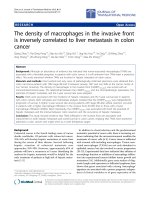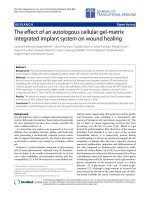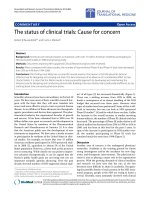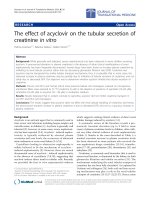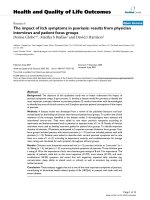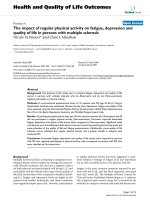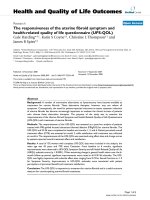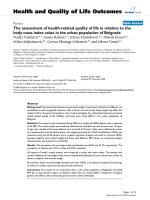Báo cáo hóa học: " The status of clinical trials: Cause for concern" potx
Bạn đang xem bản rút gọn của tài liệu. Xem và tải ngay bản đầy đủ của tài liệu tại đây (764.3 KB, 4 trang )
Nussenblatt and Meinert Journal of Translational Medicine 2010, 8:65
/>Open Access
COMMENTARY
© 2010 Nussenblatt and Meinert; licensee BioMed Central Ltd. This is an Open Access article distributed under the terms of the Creative
Commons Attribution License ( which permits unrestricted use, distribution, and repro-
duction in any medium, provided the original work is properly cited.
Commentary
The status of clinical trials: Cause for concern
Robert B Nussenblatt*
1
and Curtis L Meinert
2
Abstract
Background: Americans see clinical research as important, with over 15 million American residents participating in
NIH-sponsored studies in 2008 and growing yearly.
Methods: Documents reporting NIH supported Clinical Research projects were reviewed.
Results: When compared with other studies, the number of interventional Phase III and Phase IV trials have decreased
from 20% to 4.4% from 1994-2008.
Conclusions: This finding most likely has occurred for several reasons. One reason is that the physician lacks an
infrastructure for designing and carrying out trials. This lack is because of an absence of a coordinated effort to train
clinical trialists. It is clear that the Nation needs a more purposeful approach to developing and maintaining the
infrastructure for designing and conducting clinical trials. Building it de novo trial by trial is profoundly inefficient, to say
nothing about time consuming and error prone.
Introduction
Scientific advances have been extraordinary in the last 50
years. We have seen areas of basic scientific research bur-
geon with the hope that they will soon translate into
newer and more effective ways to treat or prevent human
disease. As an offshoot of these advances new therapeutic
agents, procedures and devices have appeared. The phar-
maceutical industry has experienced decades of growth
and success. It has been estimated that in 2004 over 30
billion dollars was spent on research and development in
the United States by members of the Pharmaceutical
Research and Manufacturers of America [1] It is clear
that the American public sees the development of new
treatments as important. We have seen a steady increase
in participation by residents of the United States in clini-
cal studies. For example, we know that over 15 million
American residents participated in NIH-sponsored stud-
ies in 2008 [2], equivalent to almost 5% of the United
States population. However, a closer look at this picture is
not so reassuring. While clearly one can point to impres-
sive advances therapeutically, it can be argued that the
Nation's public health goals are not being met nor are
important scientific agendas advancing. Over the past
decade, the total number of NIH-supported clinical stud-
ies* of all types [3] has increased dramatically (Figure 1).
There was a striking increase from 1999 to 2008, no
doubt a consequence of an almost doubling of the NIH
budget that occurred over those years. However, what
types of studies have been performed? Some of this is dif-
ficult to ascertain, but one can look at NIH-sponsored
Phase III studies** [4] and for which there are data. Unlike
the increase in the overall increase in studies involving
human subjects, the number of Phase III clinical trials has
decreased. The percentage of Phase III trials relative to all
clinical studies has decreased from 20% in 1994 to 4.4% in
2008, and has been at this level for the past 5 years. In
spite of the increase in participants in NIH studies over-
all, the number participating in Phase III trials has
remained much the same since 1998 (Figure 2).
Discussion
Another area of concern is the endangered physician/
researcher. Academia is the training ground for future
young investigators and/or the incubator for new diag-
nostic and therapeutic interventions. The physician/sci-
entist is seen as playing a major role in the regeneration
process. With the growing demands of clinical medicine
and research we have seen that the mix of the two
becomes more difficult to attain in academia. Recogniz-
ing the possible demise of such persons in the NIH intra-
mural program, people at the NIH are trying to foster a
revival. Recently, many intimately involved with clinical
* Correspondence:
1
Laboratory of Immunology, National Eye Institute, National Institutes of
Health, Building 10, Room 10N112, 10 Center Drive, Bethesda, MD 20892 USA
Full list of author information is available at the end of the article
Nussenblatt and Meinert Journal of Translational Medicine 2010, 8:65
/>Page 2 of 4
research have voiced concern that the physician/scientist
is in danger of disappearing in the academic world and
away from the NIH as well [5,6]. Investigator-initiated
clinical research is mainly NIH-sponsored in the United
States. Studies generated by physician/scientists repre-
sent the life blood of the clinical research system in the
United States.
While industry-sponsored studies are frequently well-
designed, Friedberg et al [7] reported that pharmaceutical
industry oncology drug company-sponsored trials were
less likely to report unfavorable qualitative conclusions
than those studies sponsored by non-profit organizations
(5% vs. 38%, p = 0.04). Marcia Angell has written exten-
sively about the "Me-too" drugs of the Pharmaceutical
Industry. Angell [8] reported that from 1998 to 2003, 487
drugs were approved by the FDA [9], and of those 379
(78%) were classified by the FDA as having similar quali-
ties to those already on the market. Further, 68% of these
were new formulations or combinations of old drugs.
Only 67 (14%) were considered to be new formulations.
An additional confounding issue is "globalization" of
drug development and testing. Clinical research is an area
that has been dominated by the United States and is an
important financial segment of the "new technologies"
portion of our economy. One FDA report [10] dealing
with the tracking of off-shore clinical trials was telling. It
reported that the number of foreign clinical investigators
conducting clinical research under an IND increased 16-
fold from 1990 (271) to 1999 (4,458). In addition the
number of countries in which FDA tracked drug studies
increased from 28 in 1990 to 79 in 1999 [10].
In addition to a diminishing supply of clinical research-
ers, we would suggest that a major difficulty lies with the
lack of a coordinated/focused effort to train persons in
the design, conduct, or analysis of trials. As a result, most
academic institutions lack people to work with the clini-
cian investigator. Almost any clinical investigator in any
university system knows that if he/she wishes to initiate a
trial with any significant number of participants, industry
partners are needed. The lack of infrastructure is due in
Figure 1 Total number of NIH sponsored clinical studies over a ten year period. The data were collected from yearly reports published by the
NIH Office of Research on Women's Health, "Comprehensive Reports". /> Accessed February 2010.
Nussenblatt and Meinert Journal of Translational Medicine 2010, 8:65
/>Page 3 of 4
part to the failure to recognize need for it until it is too
late. All too often there is the perception that it is not
needed. Even if there is such recognition it is difficult to
achieve because the people required are scattered
throughout Universities, largely isolated one from
another. The production of trialists is low. For example,
over the period 1991-2002, of 232 PhD dissertations at
the Bloomberg School of Public Health of the Johns Hop-
kins University, 10 were devoted to clinical trial topics; at
the University of Washington during a similar period, 3 of
132 and at Tulane University's School of Public Health
there were no clinical trial subject dissertations amongst
52 completed [11]. It is clear that the leadership of the
NIH is aware of the problems, as signaled by the previous
director (Elias Zerhouni) and his "Roadmap" [12]. Dr.
Zerhouni wrote in 2005, "It is the responsibility of those
of us involved in today's biomedical research enterprise
to translate the remarkable scientific innovations we are
witnessing into health gains for the nation" [13]. One may
criticize specific points in the roadmap, but it offers an
important vision and applauds it as a step forward. How-
ever, that said we note an absence of attention to creating
and maintaining infrastructures for trials and training tri-
alists.
One way to address the issue would be for the NIH
intramural program to initiate an integrated program that
leads to the goal of buttressing the clinical trials infra-
structure. The leaders of the NIH intramural program
have been discussing how best to re-define the intramural
role. Revitalizing the clinical research effort could be one
such area. This goal would support the programmatic
needs of all of the NIH Institutes and Centers. With more
than a thousand clinical research protocols active at any
point in time, the intramural program could become a
laboratory for clinical research, a place for exploration of
more efficient and novel ways to do clinical research, and
a place where all the important players, government, aca-
demia and industry, could collaborate. A core trans-Insti-
Figure 2 Total number of patients in NIH sponsored clinical trials. The data were collated from the same source as in Figure 1.
Nussenblatt and Meinert Journal of Translational Medicine 2010, 8:65
/>Page 4 of 4
tute training program could be established on the NIH
campus to train personnel involved at all levels of the
clinical research infrastructure.
The running of clinical trials demands a concentrated
effort by a team, including trialists, information technol-
ogy specialists, and bioethicists, in addition to clinicians;
training must include them all. In a trans-NIH effort, one
could envisage a stronger working relationship with the
Food and Drug Administration and industry. An NIH/
FDA effort could evaluate new approaches to perform
and record clinical research in order to enhance patient
safety and streamline administrative approaches. To com-
plete the paradigm shift one should envisage involvement
of the pharmaceutical industry; advantages for those in
industry that participate in these programs should be
considered. Mechanisms now exist to permit private sup-
port for intramural programs. A second mechanism
would the use of the Clinical and Translational Science
Award (CTSA) mechanism [14]. As per the NIH Road-
map, the intent is to encourage novel approaches and
methods to clinical and translational research. While
presently seeking ways to improve clinical design, biosta-
tistics, ethics, and informatics, the program should nur-
ture the development of clinical trial teams, including
training and mentoring of the trialist.
Those concerned with America's public health and the
advancement of medical care and diagnostics must look
to new paradigms to invigorate the clinical research pro-
cess, and the intramural program and the CTSA could
play an important new role in meeting the Nation's goal
of improving the health of its citizens.
*NIH definition of Clinical Studies: "The definition of
Clinical Studies for this study is taken from 45CFR46.
Clinical research is defined as: 1. Patient oriented
research. Research conducted with human subjects A (or
on material of human origin such as tissues, specimens,
and cognitive phenomena) for which an investigator (or
colleague) directly interacts with human subjects.
Excluded from this definition are in vitro studies that uti-
lize human tissues that cannot be linked to a living indi-
vidual. Patient-oriented research includes: (a)
mechanisms of human disease, (b) therapeutic interven-
tions, (c) clinical trials, and (d)development of new tech-
nologies, (2) Epidemiologic and behavioral studies, (3)
Outcomes research and health services research [3].
**The NIH-defined Phase III Clinical Trial: " usually
involving several hundred or more human subjects, for
the purpose of evaluating an experimental intervention in
comparison with a standard or controlled intervention or
comparing two or more existing treatments. Often the
aim of such investigation is to provide evidence leading to
a scientific basis for consideration of a change in health
policy or standard of care." [4]
Competing interests
The authors declare that they have no competing interests.
Authors' contributions
Both authors conceived of the study, and participated in its design and coordi-
nation and helped to draft the manuscript. Both authors read and approved
the final manuscript.
Author Details
1
Laboratory of Immunology, National Eye Institute, National Institutes of
Health, Building 10, Room 10N112, 10 Center Drive, Bethesda, MD 20892 USA
and
2
Johns Hopkins Center for Clinical Trials, 615 N. Wolfe Street, Baltimore, MD
21205 USA
References
1. Pharmaceutical Research and Manufacturers of America:
Biopharmaceutical Industry Investment in Research and Development
1980-2004. 2005 [Http://www.phrma.org].
2. Pinn VW, Roth C, Bates AC, Wagner R, Jarema K: Department of Health and
Human Services. National Institutes of Health; 2009. Monitoring
Adherence to the NIH policy on the Inclusion of Women and Minorities as
Subjects in Clinical Research. Comprehensive Report: Tracking of Human
Subjects Research in Fiscal Year 2007 and Fiscal Year 2008
3. National Institutes of Health [ />execsum.htm]
4. Pinn VW, Roth C, Bates AC, Caban CE, Jarema K: Department of Health and
Human Services. National Institutes of Health; 2005. Monitoring
Adherence to the NIH policy on the inclusion of women and minorities as
subjects in clinical research. Comprehensive report: Tracking of human
subjects research as reported in fiscal year 2003 and fiscal year 2004
5. Nathan DG, Varmus HE: The National Institutes of Health and clinical
research: a progress report. Nature Medicine 2000, 6(11):1201-1204.
6. Goldstein JL, Brown MS: The Clinical Investigator, Bewitched, Bothered,
and Bewildered-but still Beloved. J Clin Invest 1997, 99(12):2803-2812.
7. Friedberg M, Saffran B, Stinson TJ, Nelson W, Bennett CL: Evaluation of
conflict of interest in economic analysis of new drugs used in
oncology. JAMA 1999, 282(15):1453-7.
8. Angell M: Excess in the Pharmaceutical Industry. Canadian Medical
Association Journal 2004, 171:1451-1453.
9. US Food and Drug Administration Center for Drug Evaluation and
Research: NDAs approved in calendar years 1990-2003 by therapeutic
potentials and chemical types. 2004 [Http://www.fda.gov/cder/rdmt/
pstable.htm].
10. Rehnquist J, Office of the Inspector General: The Globalization of Clinical
Trials. A Growing Challenge in Protecting Human Subjects, US
Department of Health and Human Services, Editor; 2001.
11. Meinert C: Randomized Trials vs. Epidemiology? Presented at the 16th
Annual Meeting of the Society for Pediatric and Perinatal Epidemiologic
Research (SPER). Atlanta, Georgia 2003.
12. Zerhouni EA: The NIH Roadmap. Science 2003, 302:63-64. 72
13. Zerhouni EA: Translational and Clinical Science-Time for a New Vision.
New England Journal of Medicine 2005, 353:1621-1623.
14. Clinical and Translational Science Awards (Consortium): [http://
www.ncrr.nih.gov/clinicaldiscipline.asp]. Accessed 3-31-10
doi: 10.1186/1479-5876-8-65
Cite this article as: Nussenblatt and Meinert, The status of clinical trials:
Cause for concern Journal of Translational Medicine 2010, 8:65
Received: 6 April 2010 Accepted: 7 July 2010
Published: 7 July 2010
This article is available from: 2010 Nussenblatt and Meinert; licensee BioMed Central Ltd. This is an Open Access article distributed under the terms of the Creative Commons Attribution License ( which permits unrestricted use, distribution, and reproduction in any medium, provided the original work is properly cited.Journal of Tr anslational Medi cine 2010, 8:65
